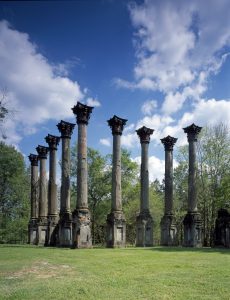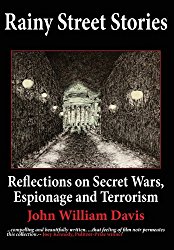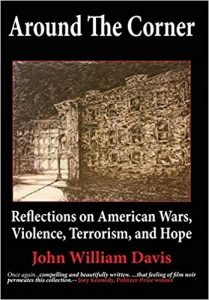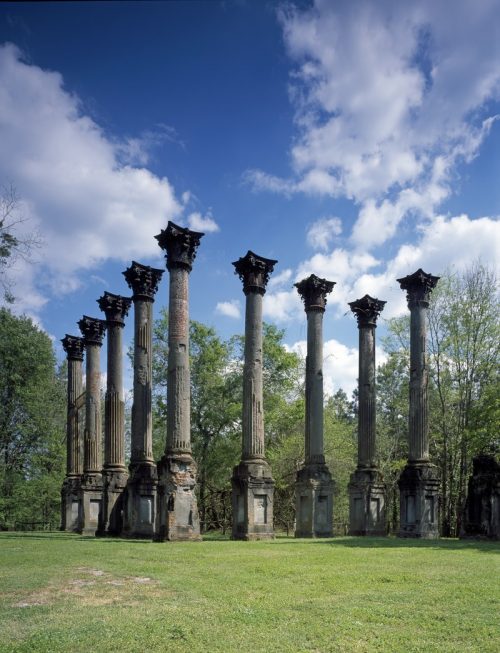Whatever happened to Windsor?
Article Written by John Davis

As a high school student I spent summers in Port Gibson, Mississippi. This is a charming little town which survived the Civil War when General Grant is said to have commented, “This town is too beautiful to burn.” His army marched through, north toward Vicksburg and history. The remarkable beauty of Port Gibson’s Church Street is illustrative. There is the Presbyterian Church with its carved, golden hand pointing to heaven atop a grand steeple. The Catholic Church with stained glass windows harbors a carved altar rail. Even a synagogue welcomes visitors on this most ecumenical of streets. Then too, there are private homes, one of which has a manicured English Garden from 1836, while others hearken back with ancient Greek Pillars, to remind us that Grecian democracy was the basis of American independence.
Here then comes the mystery. Mark Twain, in his unforgettable Life on the Mississippi spoke of using ‘Windsor Castle’ as a guide marker on the mighty river. As captain of a steamboat, he saw this this majestic building, the Windsor Plantation, from miles away. It sat prominently overlooking the river some ten miles west of Port Gibson. It was truly a grand place. So grand was this building, that generations of Mississippians remembered going to dances there, or any number of other banquets, soirees, readings, and cultural events. The mammoth home, built only months before the outbreak of war, survived along with all the other homes of Port Gibson. Sad to say, the owner didn’t live to move into his wonderful home. Nevertheless, in the years leading up to the ‘Gay 90s’ of the Nineteenth Century, the family and their hosts of friends truly enjoyed the environs of a well wrought, gigantic palatial home.
Disaster struck in 1890. A carelessly tossed cigarette ignited a waste basket full of flammables. Fire engulfed the tremendous house, and burned until literally nothing was left but the 28 titanic pillars that framed the place. Hauntingly, the pillars sit alone today, the only testimony to a society and time truly wafted away by fate and history. It should be noted that not only locals, but Hollywood noticed the almost unearthly appeal of the ruins of Windsor. Regimented pillars of brick with stucco facing and wrought iron balustrades evoked a mystery of why, and how, such a society came and then disappeared. Only questions seemed to remain where once a grand home once stood. What type of people lived, worked, loved, and died here? Such a conundrum was captured in the movie starring Elizabeth Taylor called, Raintree County.
Perhaps the most remarkable mystery about Windsor is what it looked like. For all the years, from its completion in 1861 to its burning some 30 years later, no one ever drew a picture of the place. No one knew what it looked like. Speculation by architects, by family members, and others were unable to recreate with any sense of legitimacy the actual form of the house, framed by the pillars. Then, in 1991, while researching the family records of Henry Otis Dwight, a drawing was discovered.
Dwight was in the Union Army. He was a member of the 20th Ohio Infantry which camped on the mansion’s grounds, as the soldiers made their way past Windsor, having crossed the Mississippi below Vicksburg. He took the time to draw, with exact proportions and accuracy, as gauged by the still extant pillars, what the plantation looked like. His drawing, a remarkable discovery some one hundred years after the conflagration, commemorated the monumental construction project. Now we know what the efforts of New England, local, African American and even European craftsmen accomplished, and an owner whose dream was not fulfilled in his lifetime. And now, because of a researcher’s diligence, we know what Mark Twain saw.

~Article written by John Davis
Read More from John
 John William Davis is a retired US Army counterintelligence officer and linguist. As a linguist, Mr. Davis learned five languages, the better to serve in his counterintelligence jobs during some 14 years overseas. He served in West Germany, Italy, and the Netherlands during the Cold War. There he was active in investigations directed against the Communist espionage services of the Soviet Union and Warsaw Pact. His mission was also to investigate terrorists such as the Red Army Faction in Germany, the Red Brigades in Italy, and the Combatant Communist Cells (in Belgium) among a host of others.
John William Davis is a retired US Army counterintelligence officer and linguist. As a linguist, Mr. Davis learned five languages, the better to serve in his counterintelligence jobs during some 14 years overseas. He served in West Germany, Italy, and the Netherlands during the Cold War. There he was active in investigations directed against the Communist espionage services of the Soviet Union and Warsaw Pact. His mission was also to investigate terrorists such as the Red Army Faction in Germany, the Red Brigades in Italy, and the Combatant Communist Cells (in Belgium) among a host of others.
His work during the Cold War and the bitter aftermath led him to write Rainy Street Stories, ‘Reflections on Secret Wars, Terrorism, and Espionage’ . He wanted to talk about not only the events themselves, but also the moral and human aspects of the secret world as well.

And now recently published in 2018, John continued his writing with Around the Corner: Reflections on American Wars, Violence, Terrorism, and Hope.
Two powerful books worth reading.
Read more about them in the following Six Questions:
Six Questions with John Davis: Author of Rainy Street Stories
Six Questions with John Davis: Author of Around the Corner


What majestic ruins…… thanks for sharing this, John. Loved it! We’ll make it a point to visit there someday on our many travels.
Windsor is truly worth the deviation from the main road. While there, the quaint, well maintained historical town of Port Gibson is a place you’ll never forget either.